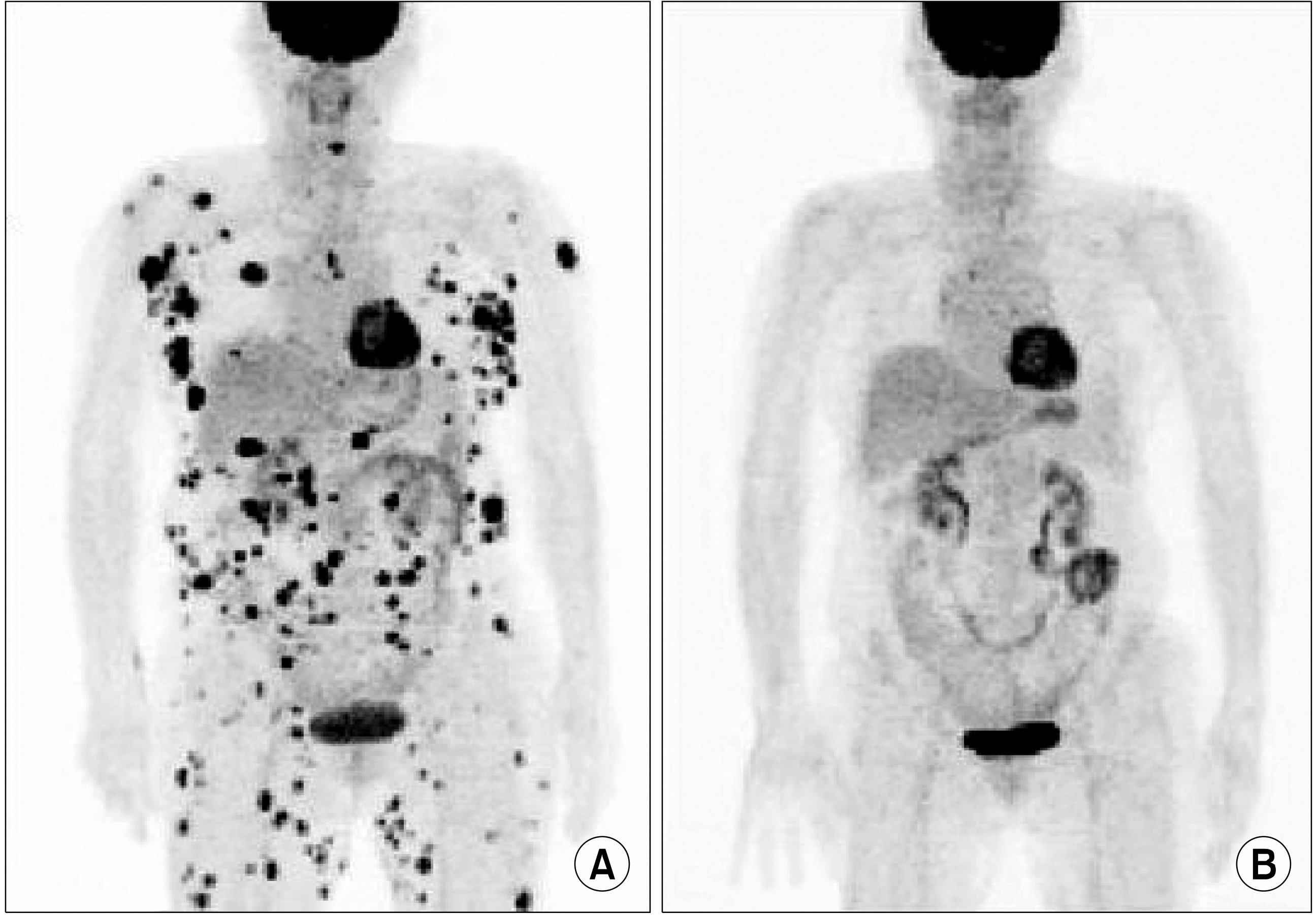Abstract
Dermatomyositis (DM) is a rare and idiopathic inflammatory myopathy with characteristic cutaneous manifestations. There is a well-recognized association between DM and cancers. In Korea, several DM cases have been reported to be associated with stomach cancer, breast cancer, acute lymphoblastic leukemia, lung cancer, and tonsil cancer. However, an association between DM and lymphoma in Korea has not been reported up to now. We report a case of DM who developed diffuse large B-cell lymphoma 1 year and 8 months later.
Go to : 
References
1. Dalakas MC. Polymyositis, dermatomyositis, and inclusion-body myositis. N Engl J Med. 1991; 325:1487–98.

2. Stertz G, Polymyositis. Berl Kin Wochenschr. 1916; 53:489.
3. Kim SM, Choi YH, Oh MD, Nam TS, Chung MH, Rai HJ, et al. A clinical analysis of 100 patients with dermatomyositis – polymyositis. Korean J Med. 1990; 39:812–23.
4. Lee SW, Jung SY, Park MC, Park YB, Lee SK. Malignancies in Korean patients with inflammatory myopathy. Yonsei Med J. 2006; 47:519–23.

5. Barnes BE, Mawr B. Dermatomyositis and malignancy. A review of the literature. Ann Intern Med. 1976; 84:68–76.
6. Ponyi A, Constantin T, Garami M, Andras C, Tallai B, Vancsa A, et al. Cancer-associated myositis: clinical features and prognostic signs. Ann N Y Acad Sci. 2005; 1051:64–71.

7. Briani C, Doria A, Sarzi-Puttini P, Dalakas MC. Update on idiopathic inflammatory myopathy. Autoimmunity. 2006; 39:161–70.
8. Racanelli V, Prete M, Minoia C, Favoino E, Perosa F. Rheumatic disorders as paraneoplastic syndromes. Autoimmun Rev. 2008; 7:352–8.

9. Chen YJ, Wu CY, Shen JL. Predicting factors of malignancy in dermatomyositis and polymyositis: a case-control study. Br J Dermatol. 2001; 144:825–31.

10. Wakata N, Kurihara T, Saito E, Kinoshita M. Polymyositis and dermatomyositis associated with malignancy: a 30-year retrospective study. Int J Dermatol. 2002; 41:729–34.

11. Carsons S. The association of malignancy with rheumatic and connective tissue disease. Semin Oncol. 1997; 24:360–72.
12. Hill CL, Zhang Y, Sigurgeirsson B, Pukkala E, Mellemkjaer L, Airio A, et al. Frequency of specific cancer types in dermatomyositis and polymyositis; a population based study. Lancet. 2001; 357:96–100.
13. Kojima M, Itoh H, Shimizu K, Saruki N, Murayama K, Higuchi K, et al. Malignant Lymphoma in Patients with Systemic Rheumatic Disease (Rheumatoid Arthritis, Systemic Lupus Erythematosus, Systemic Sclerosis, and Dermatomyositis): A Clinicopathologic Study of 24 Japanese Cases. Int J Surg Pathol. 2006; 14:43–8.

Go to : 
 | Fig. 1.Cervical lymph node biopsy. (A) Extensive replacement of normal architecture by neoplastic centrocytes and centroblasts (H&E stain, ×100), (B) Centroblastic lymphoma shows neoplastic cells that are much larger than lymphocytes (H&E stain, ×400), (C) The tumor cells are positive for CD20 stain (Immunohistochemical stain with anti-CD20 antibody, ×400) |
 | Fig. 2.Positron emission tomography. (A) Probably multiple malignant lesions on subcutaneous nodules, abdominal lymph nodes (LNs), both axillary LNs and inguinal LNs and bone involvements on T5 and C5 were shown. (B) There was no significant abnormal FDG uptake to suggest malignancy. Benign reactive LNs uptake in right lower paratracheal and both hilar space was shown. |




 PDF
PDF ePub
ePub Citation
Citation Print
Print


 XML Download
XML Download